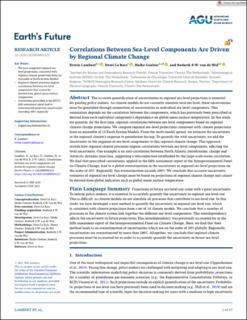| dc.contributor.author | Lambert, Erwin | |
| dc.contributor.author | Le Bars, Dewi | |
| dc.contributor.author | Goelzer, Heiko | |
| dc.contributor.author | van de Wal, Roderik S.W. | |
| dc.date.accessioned | 2021-11-12T14:48:54Z | |
| dc.date.available | 2021-11-12T14:48:54Z | |
| dc.date.created | 2021-03-02T17:55:33Z | |
| dc.date.issued | 2021 | |
| dc.identifier.issn | 2328-4277 | |
| dc.identifier.uri | https://hdl.handle.net/11250/2829412 | |
| dc.description.abstract | The accurate quantification of uncertainties in regional sea-level projections is essential for guiding policy makers. As climate models do not currently simulate total sea level, these uncertainties must be quantified through summation of uncertainties in individual sea-level components. This summation depends on the correlation between the components, which has previously been prescribed or derived from each individual component's dependence on global mean surface temperature. In this study, we quantify, for the first time, regional correlations between sea-level components based on regional climate change projections. We compute regional sea-level projections consistent with climate projections from an ensemble of 14 Earth System Models. From the multi-model spread, we estimate the uncertainty in the regional climate's response to greenhouse forcing. To quantify the total uncertainty, we add the uncertainty in the response of sea-level components to this regional climate change. This approach reveals how regional climate processes impose correlations between sea-level components, affecting the total uncertainty. One example is an anti-correlation between North Atlantic sterodynamic change and Antarctic dynamic mass loss, suggesting a teleconnection established by the large-scale ocean circulation. We find that prescribed correlations, applied in the fifth assessment report of the Intergovernmental Panel on Climate Change, lead to a global overestimation in the uncertainty in regional sea-level projections on the order of 20%. Regionally, this overestimation exceeds 100%. We conclude that accurate uncertainty estimates of regional sea-level change must be based on projections of regional climate change and cannot be derived from global indicators such as global mean surface temperature. | |
| dc.language.iso | eng | en_US |
| dc.rights | Attribution-NonCommercial-NoDerivatives 4.0 Internasjonal | * |
| dc.rights.uri | http://creativecommons.org/licenses/by-nc-nd/4.0/deed.no | * |
| dc.title | Correlations Between Sea‐Level Components Are Driven by Regional Climate Change | en_US |
| dc.type | Peer reviewed | en_US |
| dc.type | Journal article | en_US |
| dc.rights.holder | © 2021, The Authors | |
| dc.description.version | publishedVersion | |
| cristin.ispublished | true | |
| cristin.fulltext | original | |
| cristin.qualitycode | 1 | |
| dc.identifier.doi | 10.1029/2020EF001825 | |
| dc.identifier.cristin | 1895014 | |
| dc.source.journal | Earth's Future | en_US |
| dc.source.volume | 9 | en_US |
| dc.relation.project | Norges forskningsråd: 270061 | |
| dc.relation.project | Universitetet i Bergen: 100859 | |
| dc.relation.project | Norges forskningsråd: 295046 | |

